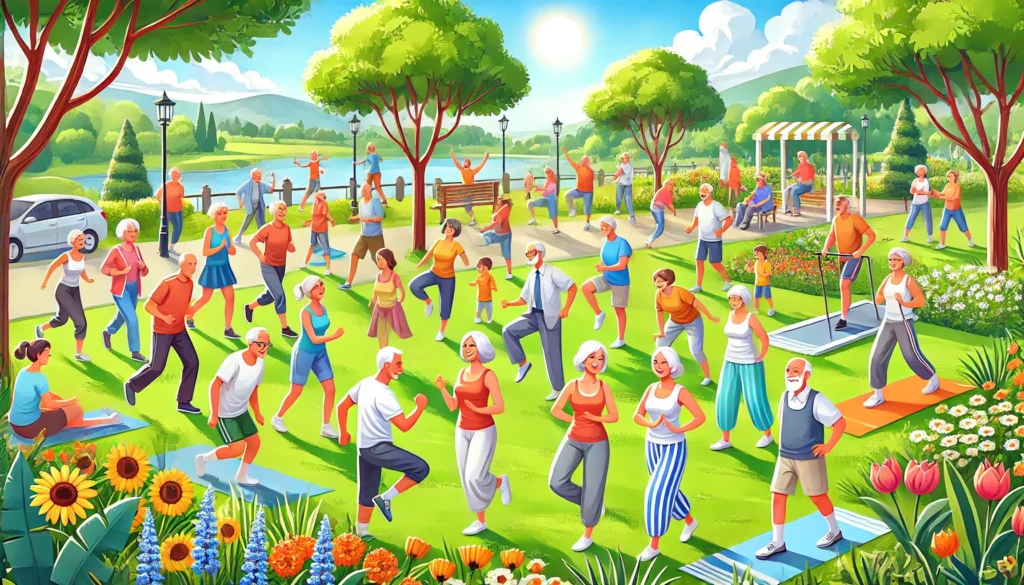Report on Home Modifications: Adapting Homes to Make Them Safer and More Accessible for Seniors
As people age, their homes may need modifications to ensure safety, accessibility, and comfort.
Home modifications can enable seniors to maintain their independence, reduce the risk of accidents, and accommodate physical limitations.
This report explores various strategies and devices for adapting homes, focusing on essential modifications like stairlifts, grab bars, and other assistive devices.
1. Assessing the Need for Home Modifications
1.1 Identifying Risk Areas
Fall Risks:
- Stairs: Stairs are a common area for falls. Evaluating the need for stairlifts, railings, and non-slip surfaces is crucial.
- Bathrooms: Wet and slippery surfaces in bathrooms pose significant fall risks. Installing grab bars, non-slip mats, and accessible shower facilities is essential.
Mobility Challenges:
- Doorways and Hallways: Narrow doorways and hallways can be difficult for seniors using walkers or wheelchairs. Widening doorways and clearing pathways may be necessary.
- Flooring: Uneven or slippery flooring can hinder mobility and lead to falls. Considering flooring options that provide better traction and are easier to navigate is important.
Accessibility Issues:
- Entryways: Steps at entry points can make it challenging for seniors to enter or leave their homes. Ramps or threshold ramps may be required.
- Cabinets and Storage: High or hard-to-reach cabinets can be inaccessible for seniors. Lowering cabinets and installing pull-out shelves can improve accessibility.
1.2 Evaluating Individual Needs
Health Conditions:
- Arthritis: Seniors with arthritis may need modifications like lever-style door handles and easier-to-use faucets.
- Vision Impairment: Those with vision impairment might require better lighting, contrasting colors, and tactile indicators to navigate their homes safely.
- Mobility Impairments: Wheelchair users may require wider doorways, lowered countertops, and roll-in showers.
Activities of Daily Living (ADLs):
- Bathing and Dressing: Assessing the need for accessible shower facilities, bath seats, and dressing aids.
- Cooking and Eating: Modifications like lower countertops, easy-to-use appliances, and accessible storage can help maintain independence in the kitchen.
Future Needs:
- Aging in Place: Planning for potential future needs by making the home adaptable, such as installing reinforcement for grab bars that may be needed later.
2. Essential Home Modifications
2.1 Stairlifts
Types of Stairlifts:
- Straight Stairlifts: Designed for straight staircases, these are the most common type and relatively easy to install.
- Curved Stairlifts: Custom-built to fit staircases with curves or landings, these are more complex and expensive but offer a seamless solution.
- Outdoor Stairlifts: Weather-resistant stairlifts for outdoor stairs, providing access to homes with outdoor steps.
Key Features:
- Swivel Seats: Allows the user to safely get on and off the stairlift at the top and bottom of the stairs.
- Safety Sensors: Detects obstacles on the stairs and stops the lift to prevent accidents.
- Battery Backup: Ensures the stairlift works during power outages, providing continuous access.
Installation Considerations:
- Structural Integrity: Ensuring the staircase can support the weight and installation of the stairlift.
- Space Requirements: Assessing the width of the staircase to determine if it can accommodate the stairlift without obstructing others.
- Cost and Maintenance: Considering the initial cost, ongoing maintenance, and potential need for repairs.
2.2 Grab Bars
Placement of Grab Bars:
- Bathrooms: Installing grab bars in the shower, near the toilet, and by the bathtub for support while standing, sitting, or transferring.
- Hallways and Staircases: Placing grab bars in hallways or alongside staircases to provide stability.
- Entryways: Adding grab bars near doors and steps to assist with balance when entering or leaving the home.
Types of Grab Bars:
- Wall-Mounted: Permanently installed into the wall, providing strong and stable support.
- Suction-Cup Grab Bars: Portable and easy to install, but less reliable for weight-bearing support. Best used as temporary aids.
- Floor-to-Ceiling Poles: Tension-mounted poles that can be installed anywhere, offering support in rooms without wall space for grab bars.
Installation Tips:
- Proper Anchoring: Ensuring grab bars are securely anchored into wall studs or using appropriate anchors to support the weight.
- Height and Positioning: Installing grab bars at the correct height and angle for the user’s needs, typically around 33-36 inches from the floor.
2.3 Accessible Bathroom Modifications
Walk-In Showers and Tubs:
- Barrier-Free Showers: Removing the shower curb for a roll-in shower that is wheelchair accessible.
- Walk-In Tubs: Tubs with doors that allow entry without stepping over a high edge, reducing the risk of falls.
Shower Seats and Transfer Benches:
- Foldable Shower Seats: Wall-mounted seats that can be folded up when not in use, providing a safe place to sit while showering.
- Transfer Benches: Extending partially outside the tub or shower, allowing users to sit and slide into the bathing area without stepping over the edge.
Handheld Showerheads:
- Adjustable Showerheads: Allows the user to direct water where needed while sitting or standing, enhancing control and comfort.
- Easy-to-Use Controls: Lever-style controls or digital systems that are easier for seniors with arthritis or limited hand strength to operate.
Toilet Modifications:
- Raised Toilet Seats: Adding height to the toilet seat makes it easier to sit and stand without straining.
- Toilet Safety Frames: Attaching a frame around the toilet provides support and stability for getting on and off.
3. Additional Assistive Devices and Modifications
3.1 Ramps and Threshold Ramps
Entry Ramps:
- Permanent Ramps: Constructed from concrete or wood, these ramps are durable and provide a long-term solution for wheelchair or walker access.
- Portable Ramps: Lightweight and foldable, these ramps can be used as needed and are ideal for temporary situations.
Threshold Ramps:
- Doorway Access: Designed to bridge small steps or uneven door thresholds, allowing for smooth entry and exit.
- Material Options: Available in rubber, aluminum, or other materials, depending on the height and location of the threshold.
Slope and Safety Considerations:
- Slope Ratio: Following guidelines for slope ratios, such as 1:12 (one inch of rise for every 12 inches of run), to ensure the ramp is safe and easy to navigate.
- Non-Slip Surfaces: Adding non-slip surfaces to ramps to prevent slipping, especially in wet or icy conditions.
3.2 Doorway and Hallway Modifications
Widening Doorways:
- Standard to Accessible Width: Expanding doorways to at least 32 inches to accommodate wheelchairs and walkers.
- Offset Hinges: Installing offset (swing-clear) hinges that allow the door to open wider without needing to remove or modify the door frame.
Lever-Style Door Handles:
- Ease of Use: Replacing traditional round door knobs with lever-style handles that are easier to grip and operate, especially for those with arthritis.
- Accessibility: Lever handles can be operated with a single hand or elbow, making them ideal for individuals with limited hand function.
Hallway Safety:
- Handrails: Installing continuous handrails along both sides of the hallway to provide support while walking.
- Lighting: Enhancing hallway lighting with motion-sensor lights or brighter bulbs to improve visibility.
3.3 Kitchen Modifications
Lowering Countertops:
- Accessible Workspaces: Lowering countertops to accommodate wheelchair users, ensuring that they can reach and use kitchen surfaces comfortably.
- Adjustable Counters: Installing counters that can be adjusted in height, offering flexibility for different users.
Pull-Out Shelves and Lazy Susans:
- Accessible Storage: Pull-out shelves and lazy Susans make it easier to reach items in cabinets without excessive bending or stretching.
- Soft-Close Drawers: Installing drawers that close gently, reducing the effort needed to use them and preventing injuries from slamming.
Easy-to-Use Appliances:
- Front-Controlled Stoves: Stoves with controls located at the front, eliminating the need to reach over hot burners.
- Side-Opening Ovens: Ovens with side-opening doors provide easier access to the interior, reducing the need to bend or reach.
3.4 Lighting and Electrical Modifications
Improved Lighting:
- Task Lighting: Adding under-cabinet lights, bedside lamps, and other task lighting to illuminate specific areas for activities like reading or cooking.
- Motion-Sensor Lights: Installing motion-sensor lights in hallways, bathrooms, and closets to automatically light up when movement is detected.
Rocker Switches:
- Ease of Use: Replacing traditional light switches with rocker switches, which are easier to operate, especially for individuals with arthritis or limited hand strength.
- Accessibility: Rocker switches can be activated with a gentle push, making them more accessible for people with mobility issues.
Smart Home Technology:
- Voice-Activated Controls: Using voice-activated systems like Amazon Alexa or Google Assistant to control lights, thermostats, and appliances without needing to move.
- Smart Plugs and Outlets: Installing smart plugs that allow seniors to control devices remotely via a smartphone or voice command, reducing the need to bend or reach for switches.
3.5 Bedroom and Living Room Modifications
Adjustable Beds:
- Comfort and Accessibility: Adjustable beds allow seniors to change the angle of the mattress, improving comfort and making it easier to get in and out of bed.
- Remote Controls: Many adjustable beds come with remote controls, allowing users to adjust positions without straining.
Furniture Risers:
- Easier Transfers: Furniture risers can be placed under bed legs or chair legs to raise the height, making it easier for seniors to sit down and stand up without assistance.
- Custom Heights: Risers come in various heights, allowing customization to the user’s needs.
Recliners and Lift Chairs:
- Power Recliners: Power recliners allow seniors to adjust their seating position with a push of a button, offering comfort and ease of use.
- Lift Chairs: Lift chairs gently raise the occupant to a standing position, providing critical assistance for those with mobility issues.
Clear Pathways:
- Furniture Arrangement: Arranging furniture to create wide, clear pathways reduces the risk of tripping and makes it easier to navigate the home, especially for those using mobility aids.
- Non-Slip Rugs: Using rugs with non-slip backing or securing rugs with tape to prevent them from sliding and causing falls.
3.6 Outdoor Modifications
Accessible Pathways:
- Smooth Surfaces: Ensuring outdoor walkways are smooth, level, and free of cracks or uneven surfaces that could cause trips or falls.
- Wide Pathways: Widening outdoor pathways to accommodate wheelchairs, walkers, or scooters.
Stair Railings and Handrails:
- Secure Handrails: Installing sturdy handrails on both sides of outdoor steps to provide support and stability.
- Weather-Resistant Materials: Using materials like stainless steel or treated wood that can withstand outdoor elements and provide long-lasting support.
Outdoor Lighting:
- Motion-Sensor Lights: Installing motion-sensor lights around entryways and along pathways to ensure they are well-lit during nighttime or low-visibility conditions.
- Solar-Powered Lights: Utilizing solar-powered lights to provide consistent outdoor illumination without the need for electrical wiring.
4. Financial Considerations and Assistance Programs
4.1 Cost of Home Modifications
Budgeting for Modifications:
- Prioritizing Needs: Assessing which modifications are most critical and creating a budget that aligns with available resources.
- Cost Estimations: Understanding the potential costs of modifications, such as stairlifts ($3,000-$15,000), grab bars ($100-$300), and ramps ($1,000-$5,000).
DIY vs. Professional Installation:
- DIY Modifications: Some modifications, like installing grab bars or changing light switches, can be done as DIY projects to save costs.
- Professional Installation: More complex modifications, such as installing stairlifts or widening doorways, typically require professional installation to ensure safety and compliance with building codes.
4.2 Assistance Programs and Funding
Medicare and Medicaid:
- Limited Coverage: Medicare generally does not cover home modifications, but Medicaid may provide assistance through Home and Community-Based Services (HCBS) waivers, depending on the state.
- Eligibility: Seniors should check with their state’s Medicaid office to determine eligibility for home modification assistance.
Veterans’ Benefits:
- VA Grants: Veterans may be eligible for grants like the Specially Adapted Housing (SAH) grant or the Home Improvements and Structural Alterations (HISA) grant, which provide funds for home modifications.
- Eligibility Criteria: Eligibility is based on service-related disabilities and specific needs for home modifications.
Non-Profit Organizations:
- Rebuilding Together: This organization offers free home modification services to low-income seniors, focusing on safety and accessibility improvements.
- Area Agencies on Aging (AAAs): Local AAAs may offer funding or assistance programs for home modifications to help seniors age in place.
Tax Deductions:
- Medical Expense Deductions: Some home modifications may be tax-deductible as medical expenses if they are necessary for medical care and do not increase the value of the home.
- Documentation: It’s essential to keep detailed records and receipts for modifications to support tax deductions.
5. Planning and Implementing Home Modifications
5.1 Developing a Modification Plan
Initial Assessment:
- Hiring a Professional: Consider hiring an occupational therapist or a Certified Aging-in-Place Specialist (CAPS) to assess the home and recommend modifications.
- Customized Solutions: Developing a plan tailored to the specific needs of the senior, considering both current and future mobility and accessibility requirements.
Involving the Senior:
- Personal Preferences: Involving the senior in the decision-making process ensures the modifications meet their preferences and comfort levels.
- Trial Modifications: Testing temporary solutions or less permanent modifications before committing to significant changes can help assess effectiveness and acceptance.
5.2 Implementation and Follow-Up
Hiring Contractors:
- Licensed Professionals: Ensuring that contractors are licensed, insured, and experienced in home modifications for seniors.
- Obtaining Estimates: Getting multiple estimates from contractors to compare costs and services before proceeding with modifications.
Quality Assurance:
- Final Inspection: Conducting a final inspection of the modifications to ensure they meet safety standards and the senior’s needs.
- Ongoing Maintenance: Establishing a schedule for regular maintenance of modifications, such as checking grab bars, stairlifts, and lighting systems to ensure they remain safe and functional.
Monitoring and Adjustments:
- Regular Reviews: Periodically reviewing the effectiveness of modifications and making adjustments as the senior’s needs change.
- Feedback from the Senior: Continuously seeking feedback from the senior to ensure they are comfortable and confident using the modifications.
Home modifications play a vital role in enabling seniors to age in place safely and comfortably.
By assessing the needs, prioritizing essential modifications, and implementing a well-planned strategy, seniors can maintain their independence and quality of life.
From installing stairlifts and grab bars to making kitchens and bathrooms more accessible, thoughtful modifications can prevent accidents, enhance mobility, and provide peace of mind for both seniors and their families.
This detailed report serves as a comprehensive guide for seniors, caregivers, and professionals involved in making homes safer and more accessible, ensuring that the home environment supports the well-being and independence of aging individuals.
Go To Hot Topics for Seniors Main










